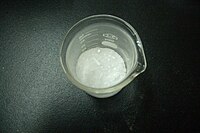Potassium chlorate
|
|
|||
 |
|||
| Names | |||
|---|---|---|---|
| Other names
Potassium chlorate(V), Potcrate
|
|||
| Identifiers | |||
|
3D model (Jmol)
|
|||
| ChemSpider | |||
| ECHA InfoCard | 100.021.173 | ||
| EC Number | 223-289-7 | ||
|
PubChem CID
|
|||
| RTECS number | FO0350000 | ||
| UNII | |||
| UN number | 1485 | ||
|
|||
|
|||
| Properties | |||
| KClO3 | |||
| Molar mass | 122.55 g mol−1 | ||
| Appearance | white crystals or powder | ||
| Density | 2.32 g/cm3 | ||
| Melting point | 356 °C (673 °F; 629 K) | ||
| Boiling point | 400 °C (752 °F; 673 K) decomposes | ||
| 3.13 g/100 mL (0 °C) 4.46 g/100 mL (10 °C) 8.15 g/100 mL (25 °C) 13.21 g/100 mL (40 °C) 53.51 g/100 mL (100 °C) 183 g/100 g (190 °C) 2930 g/100 g (330 °C) |
|||
| Solubility | soluble in glycerol negligible in acetone and liquid ammonia |
||
| Solubility in glycerol | 1 g/100 g (20 °C) | ||
| −42.8·10−6 cm3/mol | |||
|
Refractive index (nD)
|
1.40835 | ||
| Structure | |||
| monoclinic | |||
| Thermochemistry | |||
| 100.25 J/mol·K | |||
|
Std molar
entropy (S |
142.97 J/mol·K | ||
|
Std enthalpy of
formation (ΔfH |
−391.2 kJ/mol | ||
|
Gibbs free energy (ΔfG˚)
|
-289.9 kJ/mol | ||
| Hazards | |||
| Safety data sheet | ICSC 0548 | ||
| GHS pictograms |
  
|
||
| GHS signal word | Danger | ||
| H271, H302, H332, H411 | |||
| P220, P273 | |||
|
EU classification (DSD)
|
|
||
| R-phrases | R9, R20/22, R51/53 | ||
| S-phrases | (S2), S13, S16, S27, S61 | ||
| NFPA 704 | |||
| Flash point | 400 °C (752 °F; 673 K) | ||
| Lethal dose or concentration (LD, LC): | |||
|
LD50 (median dose)
|
1870 mg/kg (oral, rat) | ||
| Related compounds | |||
|
Other anions
|
Potassium bromate Potassium iodate |
||
|
Other cations
|
Ammonium chlorate Sodium chlorate Barium chlorate |
||
|
Related compounds
|
Potassium chloride Potassium hypochlorite Potassium chlorite Potassium perchlorate |
||
|
Except where otherwise noted, data are given for materials in their standard state (at 25 °C [77 °F], 100 kPa).
|
|||
|
|
|||
| Infobox references | |||
Potassium chlorate is a compound containing potassium, chlorine and oxygen atoms, with the molecular formula KClO3. In its pure form, it is a white crystalline substance. It is the most common chlorate in industrial use. It is used
On the industrial scale, potassium chlorate is produced by the Liebig process: passing chlorine into hot calcium hydroxide, subsequently adding potassium chloride: .
The electrolysis of KCl in aqueous solution is also used sometimes, in which the chloride ions formed at the anode react with KOH in situ. The low solubility of KClO3 in water causes the salt to conveniently isolate itself from the reaction mixture by simply precipitating out of solution.
Potassium chlorate can be produced in small amounts by disproportionation in a sodium hypochlorite solution followed by metathesis reaction with potassium chloride:
It can also be produced by passing chlorine gas into a hot solution of caustic potash:
Potassium chlorate was one key ingredient in early firearms percussion caps (primers). It continues in that application, where not supplanted by potassium perchlorate.
Chlorate-based propellants are more efficient than traditional gunpowder and are less susceptible to damage by water. However, they can be extremely unstable in the presence of sulfur or phosphorus and are much more expensive. Chlorate propellants must be used only in equipment designed for them; failure to follow this precaution is a common source of accidents. Potassium chlorate, often in combination with silver fulminate, is used in trick noise-makers known as "crackers", "snappers", "pop-its", or "bang-snaps", a popular type of novelty firework.
...
Wikipedia



